
Bohnanza is a card game for one to seven players designed by Uwe Rosenberg. In Bohnanza, players place cards on the table to acquire points once they remove them. Cards are allowed to be placed on other cards, only if they match – more cards stacked are worth more than fewer stacked – both in total and on average per card. Some cards are worth more than others.
In Bohnanza, players take the roles as bean farmers. Tending their crops and selling the harvested beans at the right time to get the most value for their beans and at the same time making sure there’s room for future crops when needed. This is a neccessary action as there are only a limited number of two bean fields per player available (initially).
We initially wanted to get this game into the same review as Sushi Go as they share a lot of features. In both card games, players collect cards and are rewarded with more points per card if they have acquired a larger set of matching cards. But, beyond being card games with a matching element, there are several differences between the games. The way players can acquire cards is vastly different. Also, Bohnanza presents a mechanic that forces players to play cards they might not want to play (This is, in a way, also true for the last card in Sushi Go!)
The game is fast and easy to setup. We have found it to be perfect for nights when we want to play a game, but don’t want to spend a lot of time setting the game up and an even longer time playing. After all, some week nights there’s just not enough time!
Components
Bean Cards
Soy bean
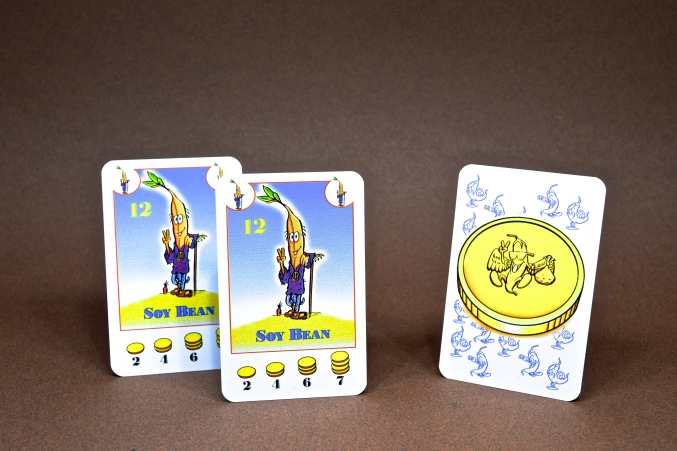
All of the bean cards share a few properties.
-First of all, they all have the respective name of the bean type written on them. This one is the Soy bean.
– They have a number written on the picture of the bean. On this card a twelve is visible against the blue. This represents the total number of that bean type in the deck.
– The cards have a list of numbers at the bottom. On this card we can see the digits 2, 4, 6 and 7 with a number of coins above them – these represent the number of cards you need for the coins you would get if you sold them. Unfortunately, it’s a bit difficult to see how many coins are illustrated on the cards.
– The two bubbles with an icon / miniature of the bean are present so that players can hold their cards tighter without having to move them apart to identify them.
– The backside depicts a coin. This works as the central, and only, currency for the game.
The scoring might be simple, but the decisions are hard. Players need to arrange their beans on two bean fields on the table so that the forced flow of beans from the hand of cards is put to good use and doesn’t ruin the growth. They can do this by deciding to place one or two cards from their hand every turn (one is mandatory, two is optional). They will also need to pick the right cards from the “market” consisting of three cards. So that they work in harmony with the flow they’ve been given by their hand of cards. During the other players’ market phases, players can make offers to buy beans that would benefit them.
Please note that Bohnanza comes with a range of different rules for different versions. The number of players also affects the rules. Try out a few different ones to see which one you like!
Below you’ll see pictures of all bean types (apart from the Soy bean that was used as an example previously).
Cocoa Bean

Garden bean
Red bean
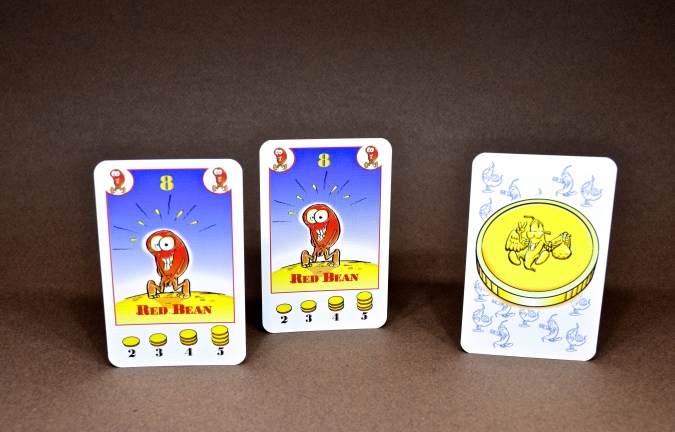
Black-Eyed bean

Green bean
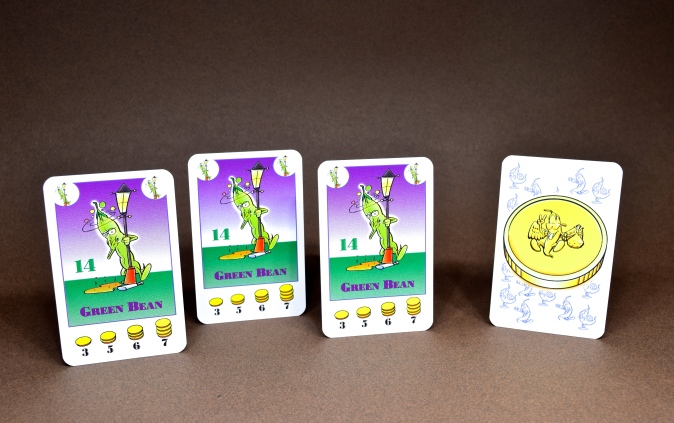
Stink bean
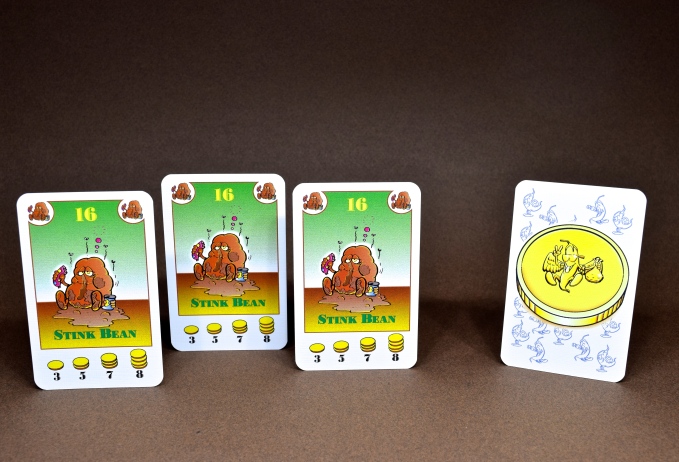
Chili bean
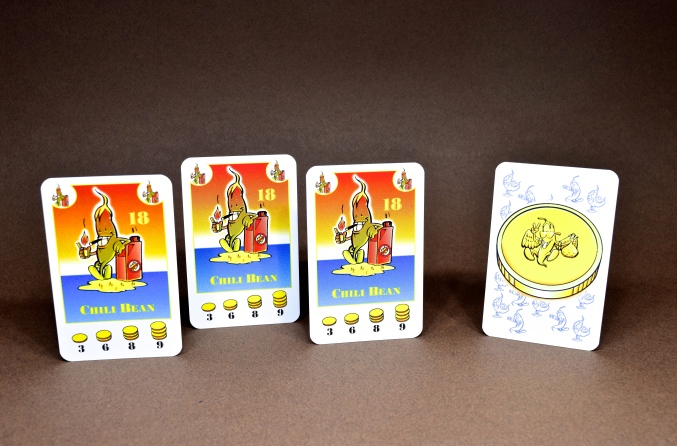
Blue bean

Wax bean
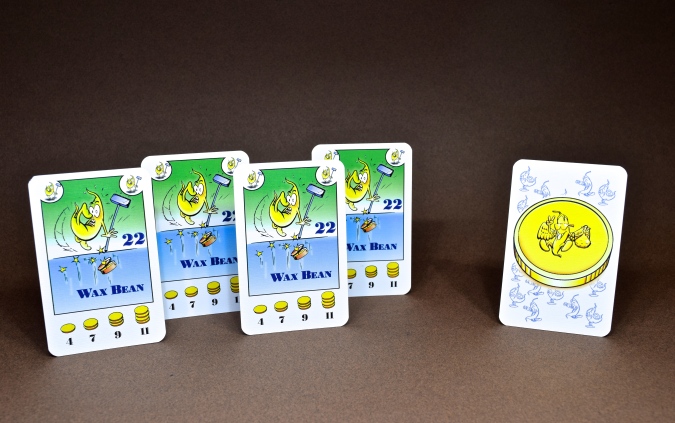
Coffee bean
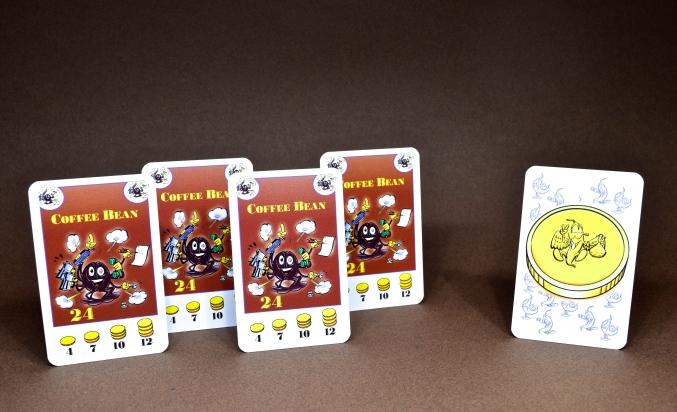
There are 154 bean cards in Bohnanza (24 Coffee Beans, 22 Wax Beans, 20 Blue Beans,18 Chili Beans, 16 Stink Beans, 14 Green Beans, 12 Soy Beans, 10 Black-eyed
Beans, 8 Red Beans, 6 Garden Beans and 4 Cocoa Beans).
Total points per card and bean type
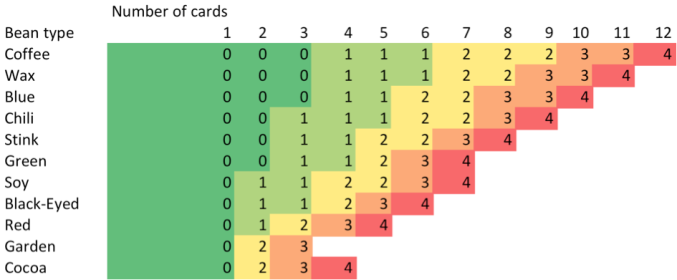
This table shows the total number of points per bean type depending on how many cards are collected.
Average points per card and bean type

This table shows the average number of points per bean type given the number of cards collected.
Please note that it’s not feasible to use a strategy to just go for the highest scoring cards, players are encouraged to follow a strategy that works with the cards in play. Waiting for the right card to score a few extra coins usually costs more than it pays.
The third bean field
Alright! So that’s the bean cards. We’ve also got another type of component that we havent talked about yet: The Thirld Bean Field.

The third bean field can be purchased by players in exchange for three coins. This extends the limitation of two fields and allows for players to grow more than two types of beans at the same time. Each player will have to decide whether or not it is reasonable to assume that the third bean field will generate at least three coins more than what would have been generated otherwise. Based on what I’ve experienced, good players (with a bit of luck) can manage two fields good enough to not be rewarded with more points by buying the third bean field. Try it out for yourself – to see how well you can utilize it!
House rules
#1 Decide on one or two pairs of bean types that generate additional points for being harvested together. As for an example: Soy beans and Wax beans generate additional points if harvested together. If a player harvests soy beans at the same time as he harvests wax beans you multiply the total score by two. This can affect players to go for cards that they otherwise wouldn’t. (Both harvests must generate at least one coin each for the bonus to be rewarded)
Version
Bohnanza – Nordic version
Publisher: Lautapelit.fi
Possible product identification number: LFCABG041
One of my faves for sure.
LikeLiked by 1 person